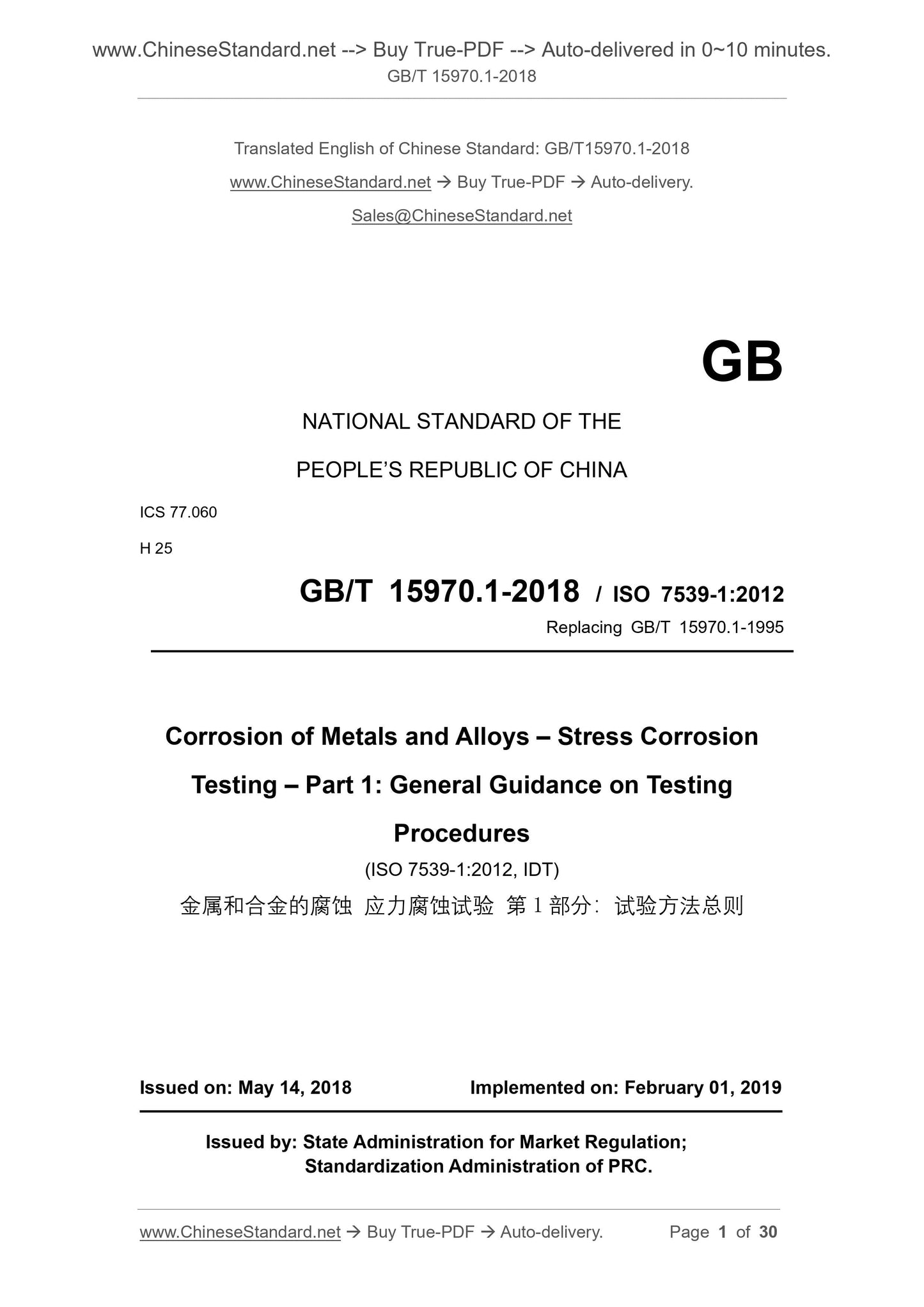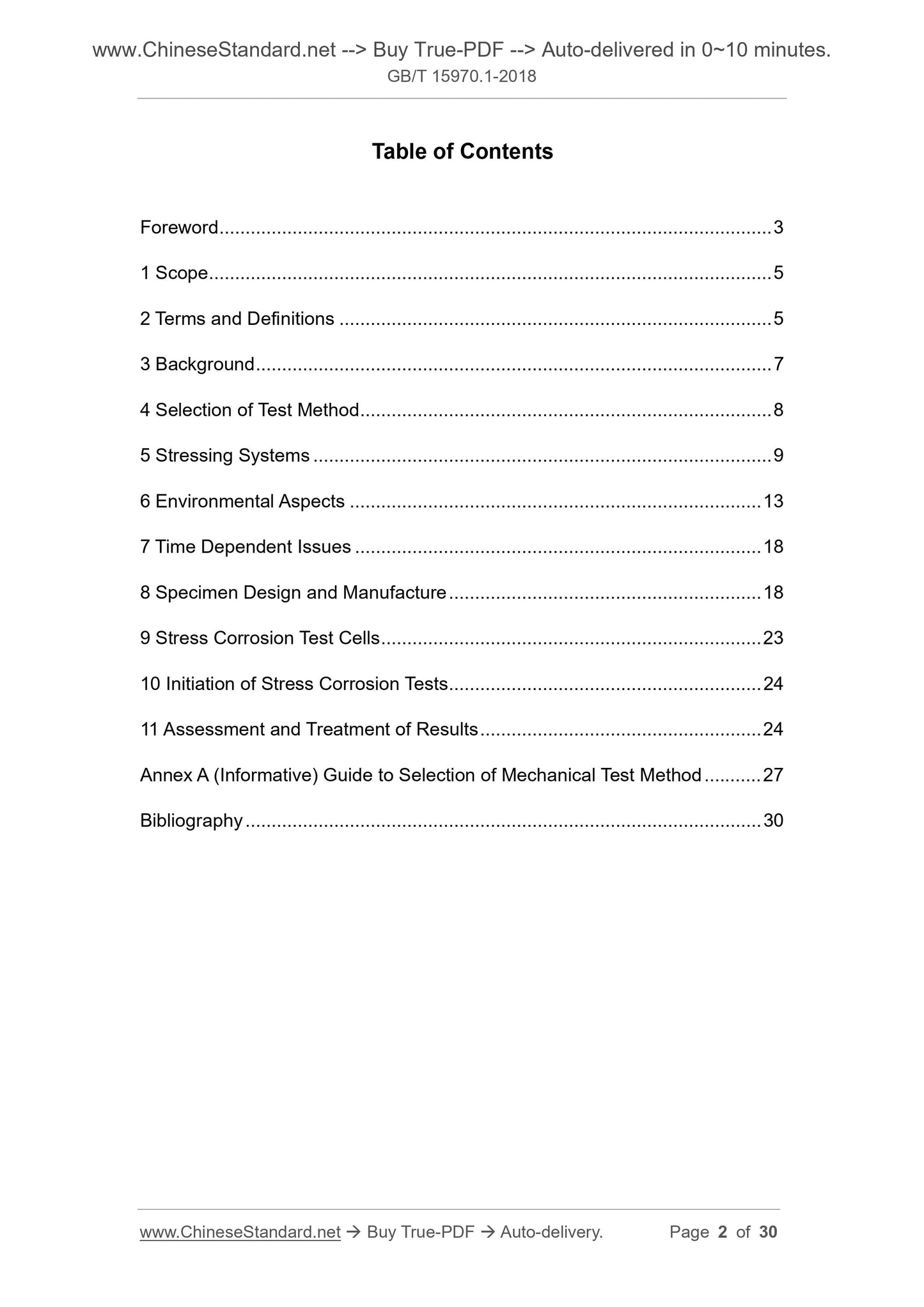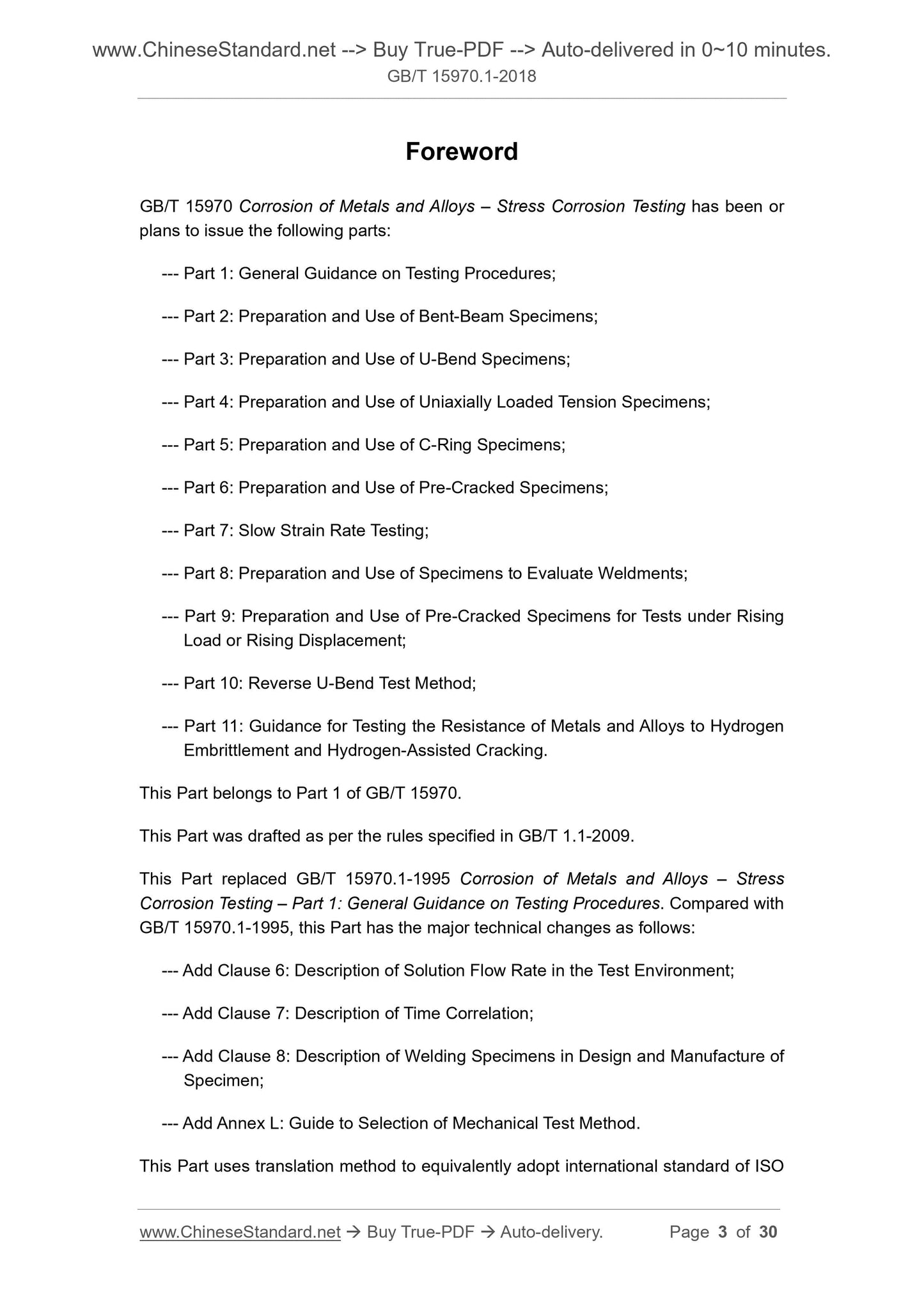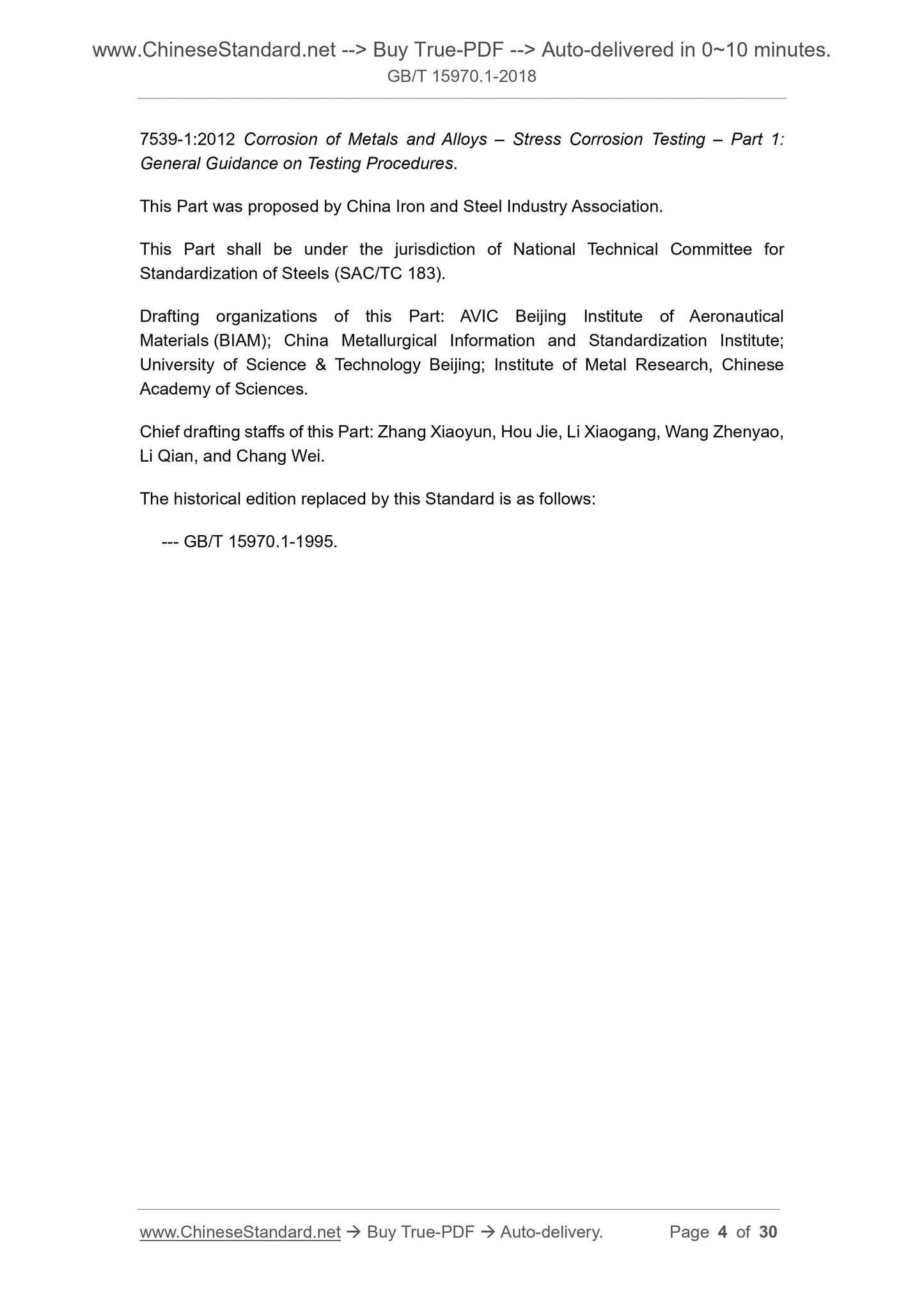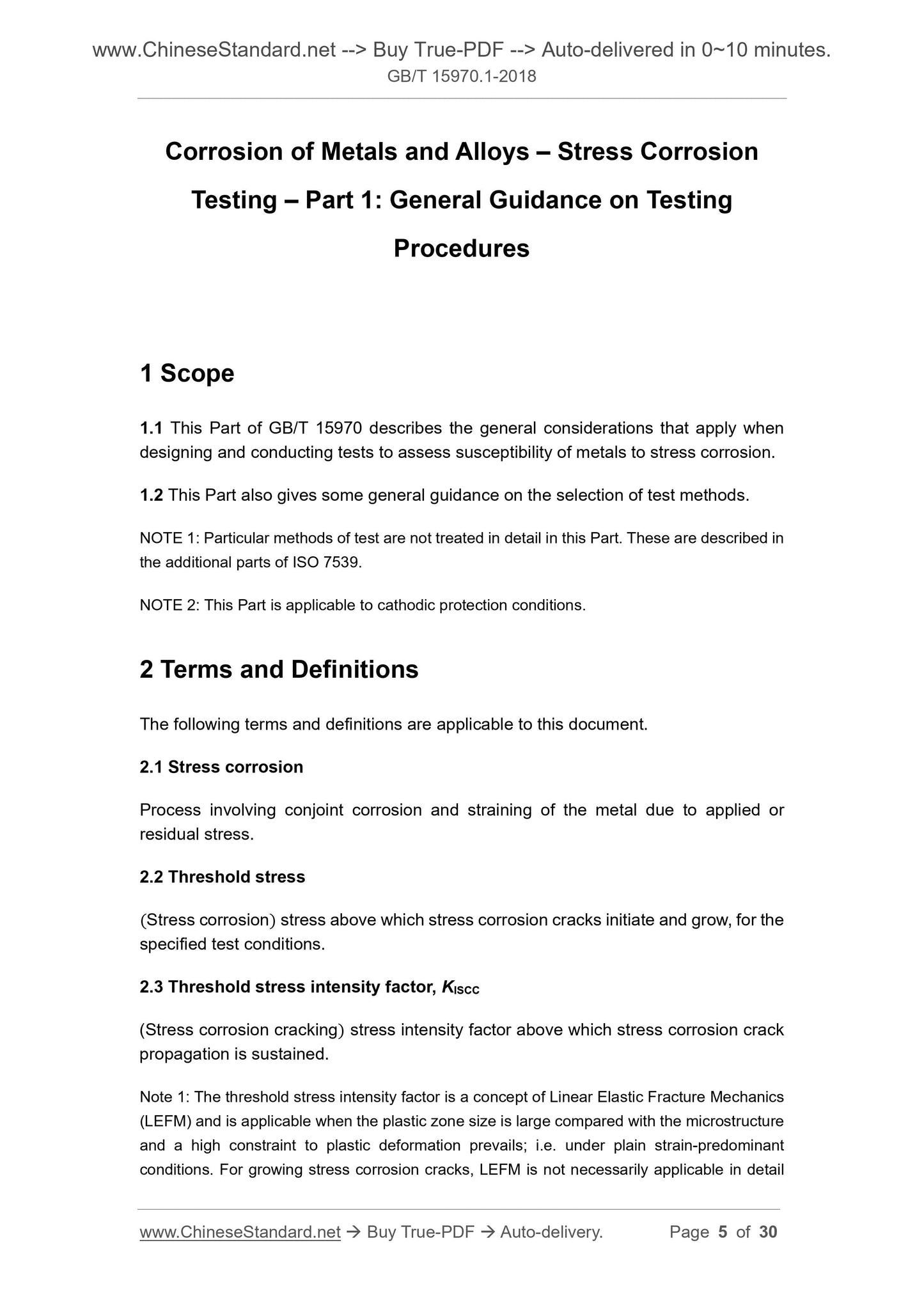1
/
of
5
www.ChineseStandard.us -- Field Test Asia Pte. Ltd.
GB/T 15970.1-2018 English PDF (GB/T15970.1-2018)
GB/T 15970.1-2018 English PDF (GB/T15970.1-2018)
Regular price
$150.00
Regular price
Sale price
$150.00
Unit price
/
per
Shipping calculated at checkout.
Couldn't load pickup availability
GB/T 15970.1-2018: Corrosion of metals and alloys -- Stress corrosion testing -- Part 1: General guidance on testing procedures
Delivery: 9 seconds. Download (& Email) true-PDF + Invoice.
Get Quotation: Click GB/T 15970.1-2018 (Self-service in 1-minute)
Historical versions (Master-website): GB/T 15970.1-2018
Preview True-PDF (Reload/Scroll-down if blank)
GB/T 15970.1-2018
Corrosion of metals and alloys--Stress corrosion testing--Part 1. General guidance on testing procedures
ICS 77.060
H25
National Standards of People's Republic of China
Replace GB/T 15970.1-1995
Corrosion stress corrosion test of metals and alloys
Part 1. General rules for test methods
Part 1. Generalguidanceontestingprocedures
(ISO 7539-1.2012, IDT)
Published on.2018-05-14
Implementation of.2019-02-01
State market supervision and administration
China National Standardization Administration issued
Foreword
GB/T 15970 "Corrosion Stress Corrosion Test for Metals and Alloys" has been or is planned to be released as follows.
--- Part 1. General rules for test methods;
--- Part 2. Preparation and application of curved beam specimens;
--- Part 3. Preparation and application of U-shaped bending specimens;
--- Part 4. Preparation and application of uniaxially loaded tensile specimens;
---Part 5. Preparation and application of C-ring specimens;
---Part 6. Preparation and application of pre-crack specimens under constant load and constant displacement;
---Part 7. Slow strain rate test;
---Part 8. Preparation and application of welding specimens;
---Part 9. Preparation and application of pre-cracked specimens under incremental or incremental displacement;
---Part 10. Reverse U-bend test method;
--- Part 11. Guide to hydrogen embrittlement and hydrogen induced cracking of metals and alloys.
This part is the first part of GB/T 15970.
This part is drafted in accordance with the rules given in GB/T 1.1-2009.
This part replaces GB/T 15970.1-1995 "Corrosion stress corrosion test of metals and alloys - Part 1
then". Compared with GB/T 15970.1-1995, the main technical changes are as follows.
--- Added a description of the solution flow rate in the test environment of Chapter 6;
--- Added a description of the time correlation of Chapter 7;
--- Added the description of welding specimens in the design and manufacture of specimens in Chapter 8;
--- Added Appendix A to the selection of mechanical test methods.
This section uses the translation method equivalent to the international standard ISO 7539-1.2012 "Corrosion Stress Corrosion Test of Metals and Alloys"
Part 1. General Rules for Test Methods.
This part was proposed by the China Iron and Steel Association.
This part is under the jurisdiction of the National Steel Standardization Technical Committee (SAC/TC183).
This section was drafted by. China Aviation Aviation Beijing Aviation Materials Research Institute, Metallurgical Industry Information Standards Institute, Beijing University of Science and Technology, China Branch
Institute of Metals.
The main drafters of this section. Zhang Xiaoyun, Hou Jie, Li Xiaogang, Wang Zhenduo, Li Qian, Chang Wei.
The previous versions of the standards replaced by this section are.
---GB/T 15970.1-1995.
Corrosion stress corrosion test of metals and alloys
Part 1. General rules for test methods
1 Scope
1.1 This part of GB/T 15970 specifies general considerations for the design and evaluation of metal stress corrosion susceptibility tests and assessments.
1.2 This section also sets out general guidelines for the selection of test methods.
Note 1. The details of the specific test methods are not described in this section. These methods are described in other parts of ISO 7539.
Note 2. This section applies to cathodic protection conditions.
2 Terms and definitions
The following terms and definitions apply to this document.
2.1
Stress corrosion stresscorrosion
The combined action of metal corrosion and strain caused by applied or residual stress.
2.2
Critical stress (for stress corrosion)
The minimum stress level required for stress corrosion initiation and expansion under specific test conditions.
2.3
Critical stress intensity factor (for stress corrosion) thresholdstressintensityfactor
KISCC
Above this stress intensity factor, the stress corrosion crack continues to expand.
Note 1. The critical stress intensity factor is the concept of Linear Elastic Fracture Mechanics (LEFM), which is applicable to microstructures.
When the size of the elastic region is larger, and the elastic deformation constraint is dominant, such as under the plane strain dominant condition. Expansion of stress corrosion cracking
Exhibitions do not have to apply LEFM details, but are often used as a utility.
Note 2. Stress corrosion cracks may originate from surface or surface defects and expand in the form of “short cracks” at stress levels below the surface critical stress intensity factor.
exhibition. However, LEFM cannot be applied to "short crack" conditions, and the crack propagation requires a stress level higher than the critical stress intensity factor.
2.4
Test environment testenvironment
The environment in which the sample is exposed can be either a use environment or a laboratory-prepared environment, which can be kept constant or agreed upon.
Change.
Note. The exposure environment required for stress corrosion of a particular material is often specific (see Chapter 6).
2.5
Start of test
The moment when stress is applied or the sample is exposed to the test environment, regardless of the order in which they are applied, the latter shall prevail.
2.6
Crack initiation time crackinitiationtime
The time from the start of the test to the detection of a crack by some means.
2.7
Expiration time timetofailure
The time taken from the start of the test to the failure. The criterion for failure is the first occurrence of a crack or the overall separation of the specimen or an agreed intermediate
condition.
2.8
Slow strain rate test slowstrainratetest
A test for evaluating the stress corrosion susceptibility of metals, usually stretching the specimen at a constant displacement rate to a fracture in a representative environment, and then evaluating
The price is its fracture sensitivity index. The strain rate is generally 10-5 s-1~10-7 s-1 in order to select the displacement rate.
Note. The slow strain rate test can also be applied to curved specimens.
2.9
Fracture strain straintofailure
In the slow strain rate test, the plastic strain is usually expressed to the strain at the time of the fracture, see ISO 7539-7.
2.10
Average crack growth rate averagecrackvelocity
The quotient of the maximum crack depth and test time produced by stress corrosion.
2.11
Orientation
The direction in which the tensile stress is applied to the sample in a particular direction relative to the product (used to prepare the sample) (ie, the rolling direction of the sheet).
3 background
3.1 It is generally believed that cracks are the result of stress corrosion, but under the action of stress, other forms, such as intergranular corrosion or crack propagation, may occur.
exhibition. For the purposes of this section, all of which are caused by the corrosive environment and tensile stress in addition to the embrittlement and exfoliation corrosion of liquid metals.
Phenomena, including the dissolution of metals or the action of hydrogen into metals, are within the scope of this section.
3.2 The methods used to evaluate metal stress corrosion properties are diverse. In some cases, each method has its own unique advantages.
3.3 The occurrence of stress corrosion depends on the exposure conditions and the mechanical properties and microscopic characteristics of the material. Stress corrosion is sensitive or not, it needs to be combined
Comprehensive judgment of materials and working conditions. Therefore, there is no fixed critical stress intensity factor for the material.
3.4 Ideally, to determine if stress corrosion occurs under the given application conditions, under all possible service exposure conditions
Perform a simulation test. In fact, this is difficult, even if it is possible. Some "standard tests" established based on experience can be given
Reasonable guidance for possible service behavior in special applications. However, these laboratory "standard tests" are only suitable for those with empirical relationships.
Conditions of Use. a test that was useful for an alloy in the past, and now a given alloy passes or fails the test, the result can be
It makes sense or doesn't make sense. If the exposure conditions are different, a test that correctly distinguishes the behavior between a given alloy may not be able to
For reliable guidance. The use of standard tests that go beyond experience requires a sufficient basis.
3.5 Special care should be taken in the following clauses. Stress corrosion processes may be sensitive to small changes in exposure or test conditions. Material user
Responsible for the selection of stress corrosion test conditions. It does not actually mean that the tests described in this section are the most in any given situation.
suitable. The reason for describing these tests in this section is that they are widely used and have a special or common equipment-environment system.
effect. The right to interpret the results of the test belongs to the material user and its interpretation is never weakened by the existence of this part.
3.6 In addition to the widest range of uses in ISO 7539, the choice of test details and the interpretation of the results are also required.
Consider more general documentation.
4 Selection of test methods
4.1 Before proceeding with the stress corrosion test plan, it should be decided which type of test is appropriate. Such decisions are mainly determined by the purpose of the test and
The information you need. Some tests are valuable to plant engineers and attempt to repeat service conditions as much as possible, while others can be used to make losses.
Research on the mechanism of action. In the former, due to limitations in materials, space, time, etc., simpler test procedures can be used; in other cases,
More complex test steps may be required. Thus, the study of crack growth rate can use pre-cracked samples, and when
Pre-cracked specimens may not be suitable for surface roughness effects. Although there are many complicated techniques, when finer techniques cannot be used,
Using simple tests has proven to be of great value in some cases.
4.2 When selecting the pass/fail test method, it is important to recognize that the selected method should not be too harsh, otherwise it will lead to the original
Materials used for specific conditions of use cannot be used; they should not be too tolerant, otherwise the material may be allowed in situations where rapid damage may occur.
use.
4.3 The purpose of stress corrosion testing is often to provide information faster than service conditions, while at the same time predicting service behavior. Achieve the purpose
The most common means are the use of higher stress, slow continuous deformation, pre-cracked specimens, test loops containing higher concentrations of chemicals than in service environments.
Environment, temperature increase and electrochemical acceleration. However, it is important to control these methods so that the details of the failure mechanism do not change.
4.4 If it is too difficult to reproduce accurate service conditions, analyze the stress corrosion process and try to determine the main factors that work at different stages.
The factors will be very useful. However, the stress corrosion test selected may only include one step of the corrosion mechanism.
4.5 See Appendix A for a brief guide to the selection of test methods.
5 loading system
5.1 Overview
5.1.1 Whether it is a smooth specimen, a notched specimen or a pre-cracked specimen, it can be loaded in the following three forms.
a) constant strain (see 5.2);
b) constant load (see 5.3);
c) Slow strain rate (see 5.4).
5.1.2 When pre-cracked specimens are used, the critical conditions are determined by the stress intensity value KISCC and the test can also be carried out under constant stress strength conditions.
Understanding the limitations of different methods is just as important as the choice of loading form.
5.2 Constant strain test
5.2.1 Since various forms of bending tests fall into this category, constant strain testing has been the most popular type of test to date. In addition, this
Class tests often simulate stresses associated with service failures.
5.2.2 Thin plates are usually tested by bending method. The thick plates are stretched or tested in the form of a C-ring. Pipe and other round cross-section semi-finished products
It can also be tested with a C-ring.
5.2.3 The advantage of the bending test is that the sample is simple, and the sample and the loading jig are inexpensive to process. During the test, the plasticity of the sample is deformed into a U-shape or
The 2, 3, or 4 point bending jig applies a bending stress or a stress lower than the bending stress to the sample. For materials with discrete yield points,
When the stress applied by the test is higher than the yield stress level, the elastic theory can be used to calculate the stress. More generally, especially for corrosion resistance
Gold, the discrete yield point is not observed, it is necessary to attach a strain gauge to the surface of the specimen until the curved specimen reaches the expected total strain level (usually high
To the maximum of 0.2% plastic strain).
5.2.4 The pipe is tested in a C-ring or O-ring type. The C-ring applies stress according to the degree of opening or closing of the opening, O-type.
The ring applies a force by forcibly inserting a plug that is suitably larger than the ring hole. C-ring to thick product form, such as aluminum alloy in short transverse direction
Also especially suitable.
5.2.5 Because the initial stress is more easily characterized and the bending specimen should take into account the stress gradient in the thickness direction of the specimen, sometimes the constant strain tensile test
Better than bending test.
5.2.6 Tethered frames shall be used for both bending and tensile tests, and the frame stiffness shall be sufficient to maintain a constant test during the test.
Displacement.
Note. Because of the stress relaxation, the stiffness of the frame used may also affect the cracking time of the specimen, not to mention any effect on the initial stress level.
5.2.7 The use of restraint frames can be avoided by using residual...
Delivery: 9 seconds. Download (& Email) true-PDF + Invoice.
Get Quotation: Click GB/T 15970.1-2018 (Self-service in 1-minute)
Historical versions (Master-website): GB/T 15970.1-2018
Preview True-PDF (Reload/Scroll-down if blank)
GB/T 15970.1-2018
Corrosion of metals and alloys--Stress corrosion testing--Part 1. General guidance on testing procedures
ICS 77.060
H25
National Standards of People's Republic of China
Replace GB/T 15970.1-1995
Corrosion stress corrosion test of metals and alloys
Part 1. General rules for test methods
Part 1. Generalguidanceontestingprocedures
(ISO 7539-1.2012, IDT)
Published on.2018-05-14
Implementation of.2019-02-01
State market supervision and administration
China National Standardization Administration issued
Foreword
GB/T 15970 "Corrosion Stress Corrosion Test for Metals and Alloys" has been or is planned to be released as follows.
--- Part 1. General rules for test methods;
--- Part 2. Preparation and application of curved beam specimens;
--- Part 3. Preparation and application of U-shaped bending specimens;
--- Part 4. Preparation and application of uniaxially loaded tensile specimens;
---Part 5. Preparation and application of C-ring specimens;
---Part 6. Preparation and application of pre-crack specimens under constant load and constant displacement;
---Part 7. Slow strain rate test;
---Part 8. Preparation and application of welding specimens;
---Part 9. Preparation and application of pre-cracked specimens under incremental or incremental displacement;
---Part 10. Reverse U-bend test method;
--- Part 11. Guide to hydrogen embrittlement and hydrogen induced cracking of metals and alloys.
This part is the first part of GB/T 15970.
This part is drafted in accordance with the rules given in GB/T 1.1-2009.
This part replaces GB/T 15970.1-1995 "Corrosion stress corrosion test of metals and alloys - Part 1
then". Compared with GB/T 15970.1-1995, the main technical changes are as follows.
--- Added a description of the solution flow rate in the test environment of Chapter 6;
--- Added a description of the time correlation of Chapter 7;
--- Added the description of welding specimens in the design and manufacture of specimens in Chapter 8;
--- Added Appendix A to the selection of mechanical test methods.
This section uses the translation method equivalent to the international standard ISO 7539-1.2012 "Corrosion Stress Corrosion Test of Metals and Alloys"
Part 1. General Rules for Test Methods.
This part was proposed by the China Iron and Steel Association.
This part is under the jurisdiction of the National Steel Standardization Technical Committee (SAC/TC183).
This section was drafted by. China Aviation Aviation Beijing Aviation Materials Research Institute, Metallurgical Industry Information Standards Institute, Beijing University of Science and Technology, China Branch
Institute of Metals.
The main drafters of this section. Zhang Xiaoyun, Hou Jie, Li Xiaogang, Wang Zhenduo, Li Qian, Chang Wei.
The previous versions of the standards replaced by this section are.
---GB/T 15970.1-1995.
Corrosion stress corrosion test of metals and alloys
Part 1. General rules for test methods
1 Scope
1.1 This part of GB/T 15970 specifies general considerations for the design and evaluation of metal stress corrosion susceptibility tests and assessments.
1.2 This section also sets out general guidelines for the selection of test methods.
Note 1. The details of the specific test methods are not described in this section. These methods are described in other parts of ISO 7539.
Note 2. This section applies to cathodic protection conditions.
2 Terms and definitions
The following terms and definitions apply to this document.
2.1
Stress corrosion stresscorrosion
The combined action of metal corrosion and strain caused by applied or residual stress.
2.2
Critical stress (for stress corrosion)
The minimum stress level required for stress corrosion initiation and expansion under specific test conditions.
2.3
Critical stress intensity factor (for stress corrosion) thresholdstressintensityfactor
KISCC
Above this stress intensity factor, the stress corrosion crack continues to expand.
Note 1. The critical stress intensity factor is the concept of Linear Elastic Fracture Mechanics (LEFM), which is applicable to microstructures.
When the size of the elastic region is larger, and the elastic deformation constraint is dominant, such as under the plane strain dominant condition. Expansion of stress corrosion cracking
Exhibitions do not have to apply LEFM details, but are often used as a utility.
Note 2. Stress corrosion cracks may originate from surface or surface defects and expand in the form of “short cracks” at stress levels below the surface critical stress intensity factor.
exhibition. However, LEFM cannot be applied to "short crack" conditions, and the crack propagation requires a stress level higher than the critical stress intensity factor.
2.4
Test environment testenvironment
The environment in which the sample is exposed can be either a use environment or a laboratory-prepared environment, which can be kept constant or agreed upon.
Change.
Note. The exposure environment required for stress corrosion of a particular material is often specific (see Chapter 6).
2.5
Start of test
The moment when stress is applied or the sample is exposed to the test environment, regardless of the order in which they are applied, the latter shall prevail.
2.6
Crack initiation time crackinitiationtime
The time from the start of the test to the detection of a crack by some means.
2.7
Expiration time timetofailure
The time taken from the start of the test to the failure. The criterion for failure is the first occurrence of a crack or the overall separation of the specimen or an agreed intermediate
condition.
2.8
Slow strain rate test slowstrainratetest
A test for evaluating the stress corrosion susceptibility of metals, usually stretching the specimen at a constant displacement rate to a fracture in a representative environment, and then evaluating
The price is its fracture sensitivity index. The strain rate is generally 10-5 s-1~10-7 s-1 in order to select the displacement rate.
Note. The slow strain rate test can also be applied to curved specimens.
2.9
Fracture strain straintofailure
In the slow strain rate test, the plastic strain is usually expressed to the strain at the time of the fracture, see ISO 7539-7.
2.10
Average crack growth rate averagecrackvelocity
The quotient of the maximum crack depth and test time produced by stress corrosion.
2.11
Orientation
The direction in which the tensile stress is applied to the sample in a particular direction relative to the product (used to prepare the sample) (ie, the rolling direction of the sheet).
3 background
3.1 It is generally believed that cracks are the result of stress corrosion, but under the action of stress, other forms, such as intergranular corrosion or crack propagation, may occur.
exhibition. For the purposes of this section, all of which are caused by the corrosive environment and tensile stress in addition to the embrittlement and exfoliation corrosion of liquid metals.
Phenomena, including the dissolution of metals or the action of hydrogen into metals, are within the scope of this section.
3.2 The methods used to evaluate metal stress corrosion properties are diverse. In some cases, each method has its own unique advantages.
3.3 The occurrence of stress corrosion depends on the exposure conditions and the mechanical properties and microscopic characteristics of the material. Stress corrosion is sensitive or not, it needs to be combined
Comprehensive judgment of materials and working conditions. Therefore, there is no fixed critical stress intensity factor for the material.
3.4 Ideally, to determine if stress corrosion occurs under the given application conditions, under all possible service exposure conditions
Perform a simulation test. In fact, this is difficult, even if it is possible. Some "standard tests" established based on experience can be given
Reasonable guidance for possible service behavior in special applications. However, these laboratory "standard tests" are only suitable for those with empirical relationships.
Conditions of Use. a test that was useful for an alloy in the past, and now a given alloy passes or fails the test, the result can be
It makes sense or doesn't make sense. If the exposure conditions are different, a test that correctly distinguishes the behavior between a given alloy may not be able to
For reliable guidance. The use of standard tests that go beyond experience requires a sufficient basis.
3.5 Special care should be taken in the following clauses. Stress corrosion processes may be sensitive to small changes in exposure or test conditions. Material user
Responsible for the selection of stress corrosion test conditions. It does not actually mean that the tests described in this section are the most in any given situation.
suitable. The reason for describing these tests in this section is that they are widely used and have a special or common equipment-environment system.
effect. The right to interpret the results of the test belongs to the material user and its interpretation is never weakened by the existence of this part.
3.6 In addition to the widest range of uses in ISO 7539, the choice of test details and the interpretation of the results are also required.
Consider more general documentation.
4 Selection of test methods
4.1 Before proceeding with the stress corrosion test plan, it should be decided which type of test is appropriate. Such decisions are mainly determined by the purpose of the test and
The information you need. Some tests are valuable to plant engineers and attempt to repeat service conditions as much as possible, while others can be used to make losses.
Research on the mechanism of action. In the former, due to limitations in materials, space, time, etc., simpler test procedures can be used; in other cases,
More complex test steps may be required. Thus, the study of crack growth rate can use pre-cracked samples, and when
Pre-cracked specimens may not be suitable for surface roughness effects. Although there are many complicated techniques, when finer techniques cannot be used,
Using simple tests has proven to be of great value in some cases.
4.2 When selecting the pass/fail test method, it is important to recognize that the selected method should not be too harsh, otherwise it will lead to the original
Materials used for specific conditions of use cannot be used; they should not be too tolerant, otherwise the material may be allowed in situations where rapid damage may occur.
use.
4.3 The purpose of stress corrosion testing is often to provide information faster than service conditions, while at the same time predicting service behavior. Achieve the purpose
The most common means are the use of higher stress, slow continuous deformation, pre-cracked specimens, test loops containing higher concentrations of chemicals than in service environments.
Environment, temperature increase and electrochemical acceleration. However, it is important to control these methods so that the details of the failure mechanism do not change.
4.4 If it is too difficult to reproduce accurate service conditions, analyze the stress corrosion process and try to determine the main factors that work at different stages.
The factors will be very useful. However, the stress corrosion test selected may only include one step of the corrosion mechanism.
4.5 See Appendix A for a brief guide to the selection of test methods.
5 loading system
5.1 Overview
5.1.1 Whether it is a smooth specimen, a notched specimen or a pre-cracked specimen, it can be loaded in the following three forms.
a) constant strain (see 5.2);
b) constant load (see 5.3);
c) Slow strain rate (see 5.4).
5.1.2 When pre-cracked specimens are used, the critical conditions are determined by the stress intensity value KISCC and the test can also be carried out under constant stress strength conditions.
Understanding the limitations of different methods is just as important as the choice of loading form.
5.2 Constant strain test
5.2.1 Since various forms of bending tests fall into this category, constant strain testing has been the most popular type of test to date. In addition, this
Class tests often simulate stresses associated with service failures.
5.2.2 Thin plates are usually tested by bending method. The thick plates are stretched or tested in the form of a C-ring. Pipe and other round cross-section semi-finished products
It can also be tested with a C-ring.
5.2.3 The advantage of the bending test is that the sample is simple, and the sample and the loading jig are inexpensive to process. During the test, the plasticity of the sample is deformed into a U-shape or
The 2, 3, or 4 point bending jig applies a bending stress or a stress lower than the bending stress to the sample. For materials with discrete yield points,
When the stress applied by the test is higher than the yield stress level, the elastic theory can be used to calculate the stress. More generally, especially for corrosion resistance
Gold, the discrete yield point is not observed, it is necessary to attach a strain gauge to the surface of the specimen until the curved specimen reaches the expected total strain level (usually high
To the maximum of 0.2% plastic strain).
5.2.4 The pipe is tested in a C-ring or O-ring type. The C-ring applies stress according to the degree of opening or closing of the opening, O-type.
The ring applies a force by forcibly inserting a plug that is suitably larger than the ring hole. C-ring to thick product form, such as aluminum alloy in short transverse direction
Also especially suitable.
5.2.5 Because the initial stress is more easily characterized and the bending specimen should take into account the stress gradient in the thickness direction of the specimen, sometimes the constant strain tensile test
Better than bending test.
5.2.6 Tethered frames shall be used for both bending and tensile tests, and the frame stiffness shall be sufficient to maintain a constant test during the test.
Displacement.
Note. Because of the stress relaxation, the stiffness of the frame used may also affect the cracking time of the specimen, not to mention any effect on the initial stress level.
5.2.7 The use of restraint frames can be avoided by using residual...
Share
